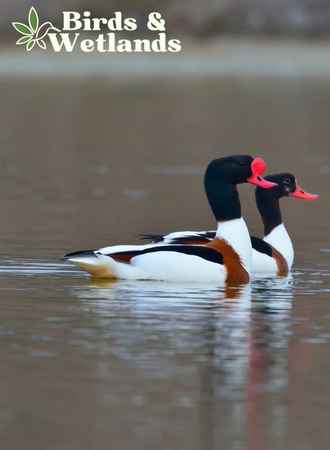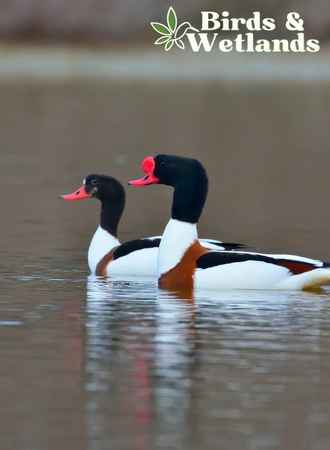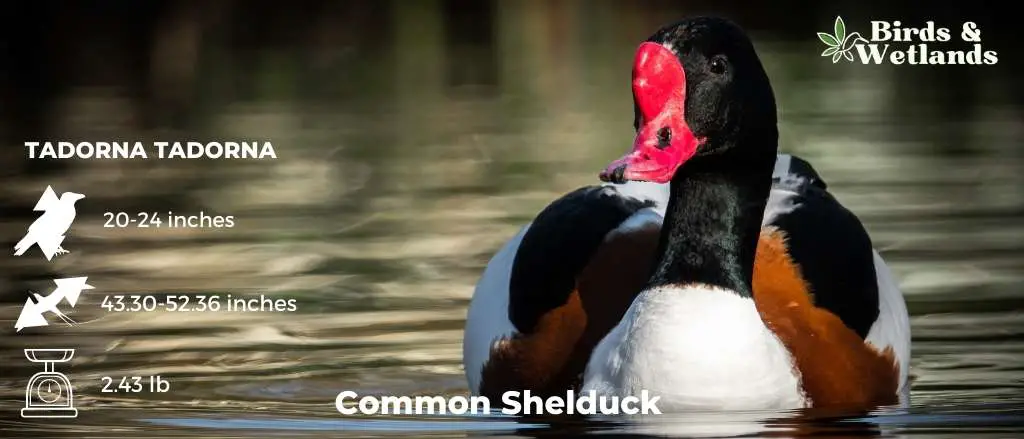The common shelduck (Tadorna tadorna) is a large, striking bird of the Anatidae family. Its vivid plumage and unique physical characteristics make it one of the most recognizable birds in its range.
Fossils of an extinct species belonging to the same distinct genus were unearthed in Bulgaria. The fossil record does not unequivocally support the present species.
Native to both the Palearctic, the common shelduck has adapted to live in a variety of wetland habitats, from cold mudflats to warm reed beds.
The common shelduck resembles a small short-necked goose in terms of shape and size.
Scientific Name: Tadorna tadorna
Height: 20-24 inches
Wingspan: 110–133 cm
Weight: 1.1 kg
Description
Adult male common shelducks are particularly starkly colored with a glossy dark green head and neck, rich reddish-pink bill or bright red bill, pink feet, and a chestnut belly patch.
Showcasing additional detail when in flight, the adult’s wing pattern possess black primary remiges and a combination of green and chestnut secondaries. These details contrast against the almost completely white underwings, making them highly visible from far away.
Adult female common shelducks are slightly smaller in size than their male counterparts. They lack the distinctive knobby forehead of the males. Instead, they have faint white facial markings on either side of their bill that further distinguishes them from males of the species.
Juveniles are similarly coloured but have duller plumage.

Listen to the Common Shelduck
Habitat & Range
The common shelduck is a migratory species that breeds in temperate and northern regions of Europe and Asia. In Europe, it breeds and largely resident in countries such as the United Kingdom, Ireland, Denmark, and the Netherlands.
In Asia, it breeds in Russia, China, and Japan. The common shelduck typically breeds in coastal areas, suitable estuaries, salt marshes, tidal mudflats and lagoons. It also sometimes breeds inland, near lakes and rivers.
Most birds spend winters in subtropical regions, while moulting flocks spend time in their favoured moulting grounds on the north German coast and the Wadden Sea.
The common shelduck is a rare vagrant in North America.

Diet & Food Habits
The common shelduck is an omnivorous species, meaning it feeds on a wide variety of plant and animal matter. Its diet typically consists of aquatic plants, mollusks, crustaceans, insects, and small fish.
The common shelduck feeds by dabbling at the water’s surface, using its bill to filter food from the water. It also sometimes upends or tips upside down in the water to reach deeper food in the water column. The common shelduck often feeds in flocks and may also form mixed-species feeding flocks with other waterfowl species.

Nesting & Mating Habits
The common shelduck species typically breeds in the spring and early summer, from April to June. In some regions, the mating season may extend into July or August.
During the breeding season, common shelducks establish territories and form pairs. Most pairs mate for life. They have been observed to nest in rabbit burrows, tree holes, haystacks and other similar nesting sites.
The female lays a clutch of 8 to 12 eggs, which she incubates alone for 28 to 30 days while the male stands guard nearby. The chicks can leave the nest, swim within a day or two of hatching, and fly at about 6 to 7 weeks. Most parents leave their partially grown young in a creche, supervised by one or two adults.

Population & Conservation Status
The population of the common shelduck is currently stable and appears to be even increasing. This species is classified by the IUCN Red List as Least Concern, indicating that it is well-protected and its conservation status is generally favorable.
While this species is not threatened with extinction, it faces habitat destruction and hunting threats in some areas of its range.
During their molting period, they are also vulnerable to diseases or natural disasters, potentially affecting their population numbers negatively.

Key Points
- Common shelducks are native to Eurasia.
- These ducks are omnivores, eating both plants and animals.
- This duck frequents salt marshes and estuaries and frequently nests in tree holes and rabbit burrows.
- Most populations spend winters in subtropical areas.
- Both sexes have dark green heads and bright red bills.


